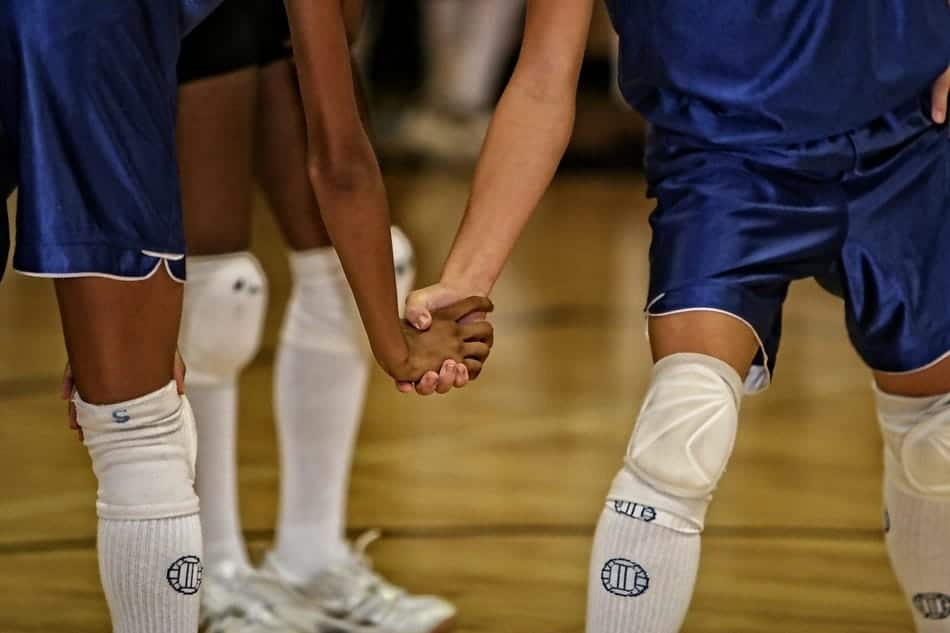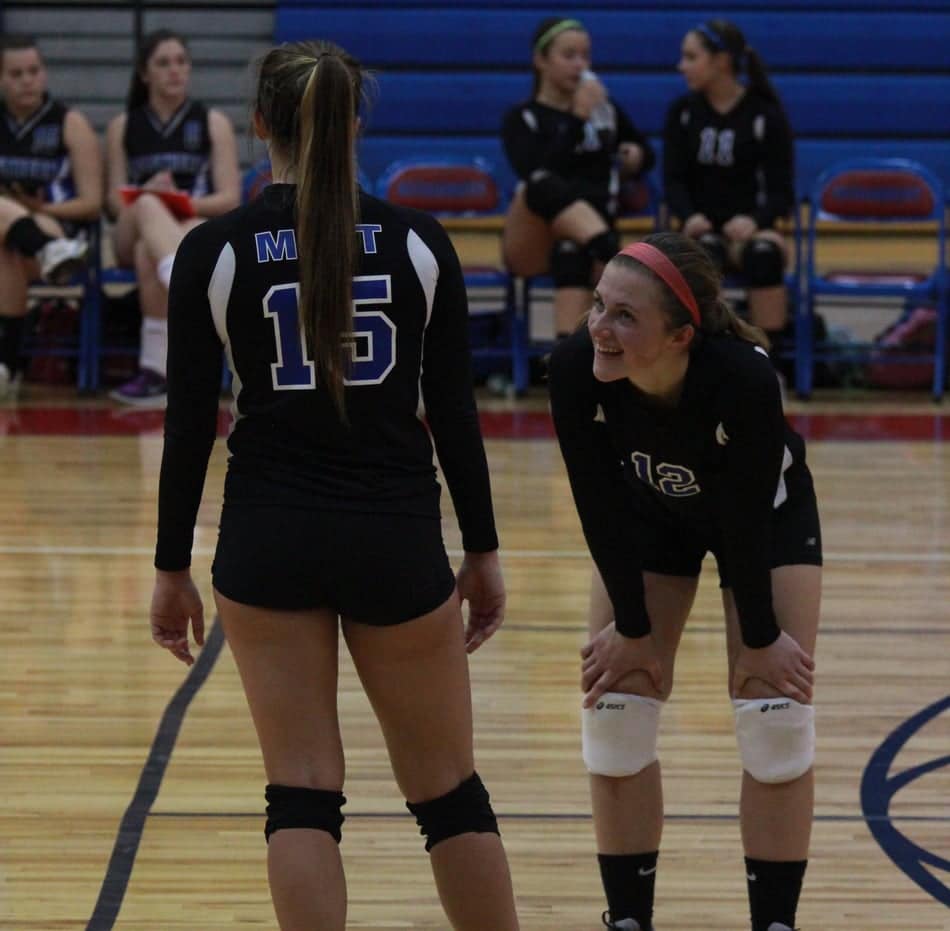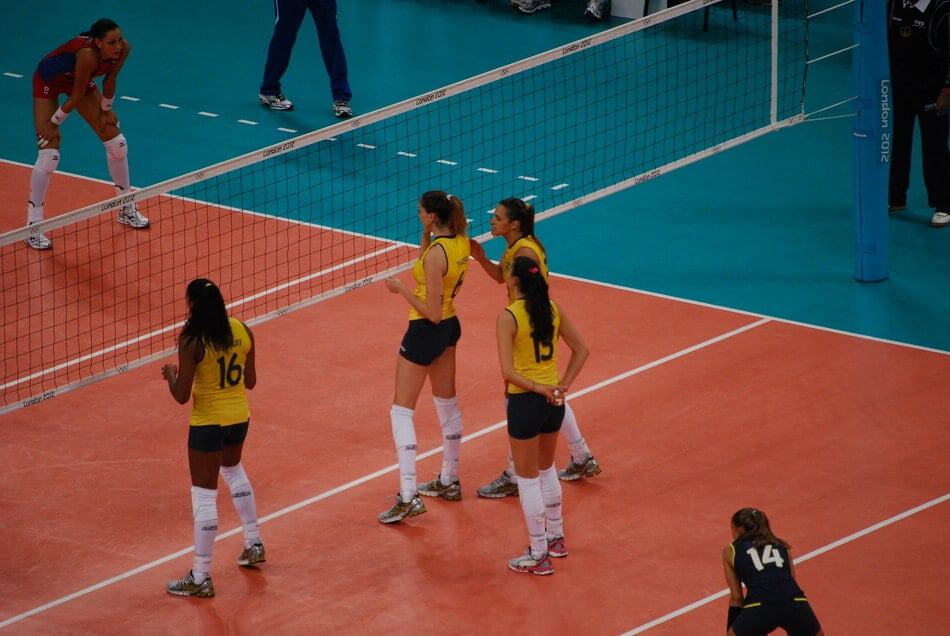During the game of volleyball, players rotate through 6 positions around their side of the court. Each time your team regains possession of the serve, the players on your team must rotate in a clockwise direction through the 6 positions.
What is rotation in volleyball? There are 8 parts to understanding rotation in volleyball
- Basic Mechanics
- How Beginners Rotate and Substitute
- Rotation Rules
- Switching
- Stacking
- Rotation is Strategic
- What is a 5-1 rotation?
- What is a 6-2 rotation?
The Basic Mechanics of Volleyball Rotation
Whenever your team gains possession of the ball after the other team has been serving, you have a new server, so everyone on your team rotates.
Rotation is when every player on your side of the court moves to the next position going in a clockwise direction. The 6 positions consist of 3 positions across the front that form a front row and 3 across the back that form the back row.

They are numbered 1-6 for ease in communication and diagramming positioning. Although the rotation moves clockwise, the numbers of the position go in the counter-clockwise direction.
Position #1 is the server’s box, the back right corner. Position 2 is the space right in front of 1 on the front row. Position 3 is the middle front, and so on around your side of the court.
Here’s a video I made talking about volleyball serving positions…
If you rather communicate it as right, middle, and left and front and back, that’s also normal. Just make sure that you use these terms as if you were looking at the court from the perspective of the server facing the net. If you are referring to the opponent’s side of the court, use the same number or terms, but from their server’s perspective, facing the net.
Again, the strange thing is, you rotate the opposite direction as the numbers of the positions. So if a player starts in the #1 position, the server’s corner, they’ll next rotate to #6, then #5, #4, and so on. The way to understand why they are numbered in the opposite order is to think about it as if you were making a list of the players on your team in the order in which they will serve.
The first would be the one who is already in that position, then, the next time your team wins possession of the
How Volleyball Beginners Rotate and Substitute
When you first learn volleyball, it’s usually in gym class or in a beginner’s league like maybe at the YMCA. In these situations, the goal of the game is not competitive, it’s fun, exercise and learning.
So involving everyone is the key motivation. Sometimes the rules are adjusted to allow 9 positions on the court just to get more involvement.
In these settings, whether using 6 positions or 9, it’s very common for everyone to just rotate through the cycle of positions and substitute when you get to the end. Typically the person will rotate into the serving position and rotate through and exit the front row.
There’s no strategy involved here, no coach assessing skills or performance, rotation and substitutions are simply on auto-pilot. This is understandable and good in this setting.
Everyone gets to play an even amount. They get to learn without preference and hopefully find a new sport that they love. Everyone gets a chance to try each position and learn the rules of the game.
As soon as you enter a competitive setting, this auto-pilot mode should vanish. Coaches need to have clear priorities: are we playing for fun or are we playing to win? Playing for fun is fine and good as long as that’s suitable for the setting and clearly communicated to players and parents.
If we are playing to win, equal playing time goes out the window. Playing time then becomes earned through hard work and performance.
Substitutions are then at the discretion of the coach. Once you’re playing at this level, the rotation just flows in a circle around the court, no one will “rotate off” the court.
If you would like to learn more about advanced substitutions, this article is all about substitutions.
Would you like to shop for our favorite recommended player products? Choose the item below and click to shop on Amazon.
Volleyball Rotation Rules
Whenever the point is about to start, you must be in your rotation position. You have to stay in the position until the serve contact is made, then you are free to move anywhere around the court. You must keep track of this position for the next point. If just one player is out of the rotation, your team will automatically lose the next point regardless of who is serving.
The actual spot or space that you stand on the court is flexible and formations can be stretched to get players to a place that gives them a strategic advantage. You don’t have to be evenly spaced out in a straight line, you simply have to be ahead or behind the players in the opposite row, and to the right or left of the people in your row. The referee has to be able to tell that you are slightly closer to or further from the net or the given side than the player next to you – that you are in order going around the perimeter of the court.
It’s very common to see players squished up to the net and even all the way in the corner. This is perfectly fine as long as they are in the correct rotational order.
You can actually stand right next to each other and some players will hold the hand of their teammate if they plan to immediately switch places, to pull each other in the opposite direction quickly. As long as one part of your foot is further in the direction you are supposed to be than the other player, you can be in the correct rotational position.
Switching Positions in Volleyball
After the contact of the

You want to move to your intended position as early in the rally as possible, but only when you have time to do so without messing up your team. Not everyone has to move at the same time. When your team serves, you can switch immediately and your whole team should have no trouble moving to their correct spots while the other team is receiving.
When your team is receiving your back row needs to be allowed to play the ball without confusion or interference. Your coach should give you direction on their expectations for this. Sometimes teams will stay in their beginning positions for one possession of the ball, then transition and switch after sending their attack over.
Typically back row players don’t switch to the front row except for the setter. The players who are in the back row of the rotation are free to play in the front, but they aren’t allowed to contact the ball above the height of the net in front of the 10-foot line.
So think about that, they can’t block or jump and hit! Why would you want them to be in the front? Mainly they will only move to the front when scrambling to save a ball to get it back in play.
Stacking in Volleyball
I know, there are so many terms in volleyball, right? Stacking is one that you’ve probably seen, but may rarely hear what it’s called.
Stacking in volleyball is when you line up following the rotational position rules with players tightly placed together to create less movement after the serve. Your coach can select a position and anchor the lineup around that player by stacking players in a way that doesn’t break the rules but allows the initial player to have an advantage.

So if your team is serving, one common tactic is to have the middle blocker as close to her regular blocking position as possible and line the other players up accordingly. Why? She will most likely be the first player on your team that has to be engaged in the play, so getting her as close to where she needs to be ahead of time allows her to focus on blocking, not running past someone else to get to her spot.
Another example is during serve receive, when the setter is in either of the right positions or middle positions, stacking in a way that gets her closer to her usual setting position. In this way, she can be more focused and ready to set
Stacking is simply a pre-serve strategy that coaches can use to set their players up for success at the beginning of the rally.
If you would like to learn more about the positions in volleyball, check out this article next.
Rotation Is Strategic
So there are 2 common strategies for rotation. At the higher levels, rotation doesn’t just refer to the actual movement of players from one position to the next, but also the offensive scheme.

Think of how the football coach guides his team’s offense by creating a style of offense and then calling plays within that style. In volleyball, it’s more subtle but just as important. The term rotation also refers to this scheme and system.
Coaches choose the system they will use depending on their experience and preference but also depending on the composition of their team. The 2 schemes are the 5-1 rotation and the 6-2 rotation.
What Is A 5-1 Rotation in Volleyball?
The most common rotation throughout American volleyball is the 5-1 rotation. In this system, you have 1 setter and 5 hitters. The setter functions as the setter from every position on the court, whether on the front row or back.
The strength in this scheme comes from the consistency in the setting. When the setter remains the same throughout the entire game, the hitters know what to expect and they can develop a groove and a flow.
Besides the consistency of the actual sets; the height, the timing, and the placement, the 5-1 rotation also provides a consistent leader. The setter is the leader on the court because every offensive play runs through their hands. They make the decisions and communicate the expectations to the hitters.
When you have 1 setter all around the court, you get a consistent voice and game plan. Your whole team knows who is calling the shots on every single play.
What Is A 6-2 Rotation in Volleyball?
The 6-2 rotation is the second most common strategy that coaches use. You may be thinking – how can it be called 6-2 when there are only 6 players on the court?
In the 6-2 rotation, you have 6 hitters on the court at all times because you have 2 hitters that also play setter. When the first is playing the setter role from the back row, the other is an opposite hitter on the front.
As they rotate through the positions, they stay opposite of one another so that one is always in the back. Playing your setter from the back row allows more offensive options since back row players cannot hit from in front of the 10-foot line.
Obviously, you have to have the right personnel for this scheme. You need 2 very good setters that are also strong hitters. They also need to be effective as blockers, since they will be essentially playing the position of the hitter half of the points in every game.
One of the benefits to this system is that you always have 2 setters on the court, which means if the one playing the setter role at the moment has to take the first ball, the second setter can make the set. Another benefit is that this is squeezing the most offense out of the 6 positions that you possibly can.
If you have further questions about rotation, there’s a more recent article about it called When to Rotate in Volleyball.
Related Questions
Does The Server Have A Rotational Position?
In volleyball, the server is not part of the rotation while serving. Once the serve is in play, the server can run into the court where they operate under the same rules as being any other player on the back row.
A long time ago, the server had to stand in the right corner of the end line. Some old gym floors may still have the little line that designated the left limit of where the server was allowed to stand.
That isn’t the rule anymore, the server is allowed to stand anywhere along the end line between the side boundaries. This is much fairer since left-handed and right-handed players would have an unequal challenge of controlling the ball’s placement around the court from the back right corner.
Does The Libero Rotate In Volleyball?
The libero does rotate along with the other players while she is on the court. She has unlimited substitutions on the back row, but she must leave the court for one point in between replacing different players unless she is taking the server’s position (if it’s her turn to serve).
So typically the libero will enter the court in position 1 (either to serve or replace the server after she has lost her serve), rotate along the back row through positions 6 and 5, and exit the court as she would be forced to move up to position 4 on the front row. She is not allowed to play the front row.
Would you like to learn more about the libero position?
What Is The Attack Line In Volleyball?
The attack line is also called the 10-foot line or the 3-meter line. It runs parallel to the net. Players who are in the front row positions may attack anywhere on the court, but back row players may not attack in front of the attack line. In other words, the back row players may hit, but they have to be behind the 10-foot line when they leave the ground or make contact with the ball.
If you would like to learn more about the attack line, check out another one of our articles here.
Photo credits:
Feature image by Tania Van den Berghen from Pixabay
Switching image by Keith Johnston from Pixabay
Stacking image by amandalyn_a on flickr.com: https://creativecommons.org/licenses/by-sa/2.0/, cropped for size.
Team rotation image by Matt Sims on flickr.com: https://creativecommons.org/licenses/by/2.0/
Recent Posts
Athletes, listen up! Do you have a closet full of old jerseys, sweatpants, and tees that you just can't seem to part with? Well, dust them off, because you're sitting on a goldmine of fashion...
You may have heard, or you may have noticed, that there's been a change to the rule about double contact in volleyball. In 2022, an experimental rule change began to be implemented, where the double...
